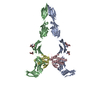+Search query
-Structure paper
| Title | Cryo-EM analyses of KIT and oncogenic mutants reveal structural oncogenic plasticity and a target for therapeutic intervention. |
|---|---|
| Journal, issue, pages | Proc Natl Acad Sci U S A, Vol. 120, Issue 13, Page e2300054120, Year 2023 |
| Publish date | Mar 28, 2023 |
 Authors Authors | Stefan G Krimmer / Nicole Bertoletti / Yoshihisa Suzuki / Luka Katic / Jyotidarsini Mohanty / Sheng Shu / Sangwon Lee / Irit Lax / Wei Mi / Joseph Schlessinger /  |
| PubMed Abstract | The receptor tyrosine kinase KIT and its ligand stem cell factor (SCF) are required for the development of hematopoietic stem cells, germ cells, and other cells. A variety of human cancers, such as ...The receptor tyrosine kinase KIT and its ligand stem cell factor (SCF) are required for the development of hematopoietic stem cells, germ cells, and other cells. A variety of human cancers, such as acute myeloid leukemia, gastrointestinal stromal tumor, and mast cell leukemia, are driven by somatic gain-of-function KIT mutations. Here, we report cryo electron microscopy (cryo-EM) structural analyses of full-length wild-type and two oncogenic KIT mutants, which show that the overall symmetric arrangement of the extracellular domain of ligand-occupied KIT dimers contains asymmetric D5 homotypic contacts juxtaposing the plasma membrane. Mutational analysis of KIT reveals in D5 region an "Achilles heel" for therapeutic intervention. A ligand-sensitized oncogenic KIT mutant exhibits a more comprehensive and stable D5 asymmetric conformation. A constitutively active ligand-independent oncogenic KIT mutant adopts a V-shaped conformation solely held by D5-mediated contacts. Binding of SCF to this mutant fully restores the conformation of wild-type KIT dimers, including the formation of salt bridges responsible for D4 homotypic contacts and other hallmarks of SCF-induced KIT dimerization. These experiments reveal an unexpected structural plasticity of oncogenic KIT mutants and a therapeutic target in D5. |
 External links External links |  Proc Natl Acad Sci U S A / Proc Natl Acad Sci U S A /  PubMed:36943885 / PubMed:36943885 /  PubMed Central PubMed Central |
| Methods | EM (single particle) |
| Resolution | 3.17 - 13.1 Å |
| Structure data | EMDB-27408, PDB-8dfm: EMDB-27410, PDB-8dfp: EMDB-27411, PDB-8dfq:  EMDB-27495: Full-length KIT(T417I,delta418-419) dimers  EMDB-27496: Full-length KIT(T417I,delta418-419) dimers |
| Chemicals |  ChemComp-NAG: |
| Source |
|
 Keywords Keywords | TRANSFERASE / receptor tyrosine kinase / cell signaling / cancer / cryo-EM / KIT / stem cell factor / oncogenic mutant / extracellular domain / asymmetric interface / structural plasticity |
 Movie
Movie Controller
Controller Structure viewers
Structure viewers About Yorodumi Papers
About Yorodumi Papers









 homo sapiens (human)
homo sapiens (human)